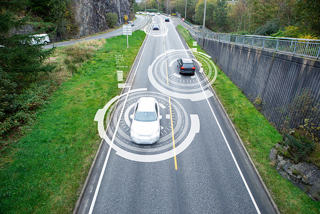UK Connected Intelligence Transport Environment (UK CITE), a project to create the most advanced environment for testing connected and autonomous vehicles, demonstrated its latest innovations at Jaguar Land Rover’s Gaydon site.
The project will create the UK’s first fully connected infrastructure, using a combination of wireless technologies, which can enable real-world testing in a safe and managed way.
The event displayed the technological advances made by the consortium to key partners, covering stakeholders from the automotive industry, technology and infrastructure providers and operators, and academia.
Claire Lewis, senior business development manager at lead consortium partner Visteon, said: “These technologies are set to have a wide societal and infrastructural impact. With advanced warnings of Emergency Vehicles on the road response times will improve, as traffic proactively responds to their presence. In the same vein, a more informed understanding of road conditions will allow traffic pressures to ease on the road.”
Talking car technologies were demonstrated, including the consortium’s Emergency Vehicle Warning (EVW), Emergency Electronic Brake Light (EEBL), Road Works Warning (RWW) and Traffic Condition Warning (TCW).
These connected technologies allow cars to communicate with each other and the road infrastructure, providing intelligent insight on road conditions.
All of the technologies demonstrated at Gaydon provide advanced warning to the driver. This intelligent insight in to road conditions is a key benefit to Connected Vehicles, whether manned or autonomous. For instance, advanced warning that a car in front of you has applied its brakes, with no line of sight, offers obvious advantages to the user who can anticipate the need to alter their driving and avoid any potential accident.
The project is funded by the Government’s £100m Connected and Autonomous Vehicle fund, delivered by Innovate UK. The project is worth a total of £7.1m including investment from the Government and Highways England.
Ian Thompson, senior technical adviser at Highways England, said: “We’ve been working with our UK CITE partners to install the infrastructure needed to help vehicles communicate with each other and the environment around them. Safety is our top priority and the safety of road users will continue to be an integral part of this project, especially during any on-road testing of this emerging technology.”
“During the Year of Engineering, this is an exciting technology-led project to be working on and shows how rewarding and varied a career in the highways industry can be.”



















Login to comment
Comments
No comments have been made yet.